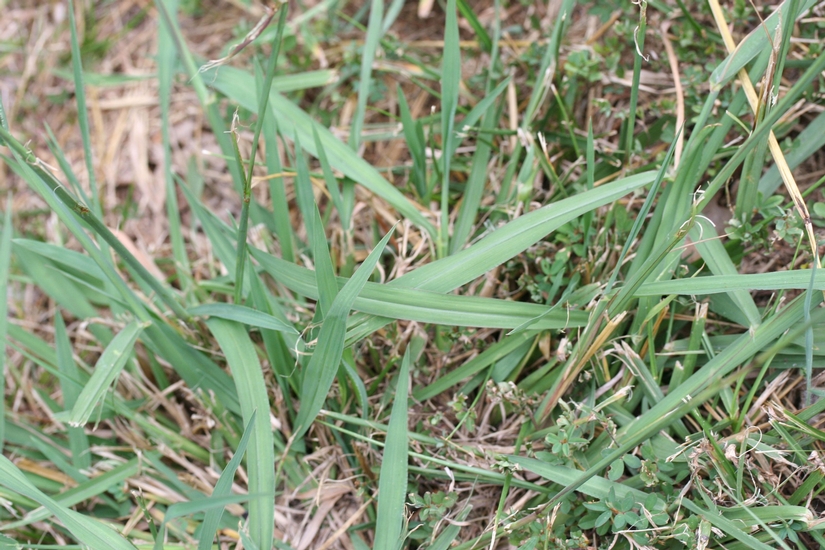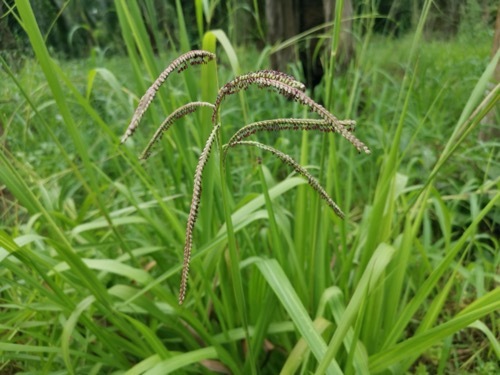Identifying Dallisgrass can be done by looking for distinctive V-shaped seed heads and dense clumps of grass blades. Dallisgrass, a common warm-season perennial grass, can be recognized by its unique characteristics.
Its seed heads form a V-shape, and it grows in dense clumps with blades that are wider, coarser, and lighter green in color compared to other grasses.

Credit: weedid.missouri.edu
What Is Dallisgrass?
Dallisgrass (Paspalum dilatatum) is a perennial grass weed that is commonly found in lawns, pastures, and disturbed areas. It is native to Uruguay and Argentina and was introduced to the United States as a forage grass. However, it has become a problematic weed due to its aggressive growth habits and ability to outcompete desirable grass species.
Appearance
Dallisgrass can be identified by its distinct appearance. It typically has broad, flat, and coarse leaves that are arranged in a distinctive star-like pattern at the base of the plant. The stems of dallisgrass are upright and can reach up to 3 feet in height. One of the most notable features of dallisgrass is its seed heads, which are triangular-shaped and bear a striking resemblance to a turkey foot.
Growth Habits
Dallisgrass exhibits rapid growth and spreads via rhizomes and seeds, enabling it to quickly colonize areas and compete with desirable turfgrasses. It thrives in warm-season climates and is particularly problematic in the southern regions of the United States. Dallisgrass can tolerate a wide range of soil types and is often found in heavily trafficked areas, such as roadsides, lawns, and athletic fields.
Signs Of Dallisgrass Infestation
If your lawn is experiencing patchy and uneven growth, a thick and coarse texture, and distinct seed heads, you might be dealing with a dallisgrass infestation.
1. Patchy And Uneven Growth
Dallisgrass infestation can cause patchy and uneven growth patterns across your lawn. This weed often outcompetes other grass species, resulting in bare spots and thinning sections. These uneven growth patterns can disrupt the overall appearance of your lawn, making it less visually appealing.
2. Thick And Coarse Texture
A telltale sign of dallisgrass infestation is the thick and coarse texture of the weed in comparison to the surrounding grass. The leaves of dallisgrass are wider and coarser, giving a different texture when touched. When you walk barefoot on your lawn, you may notice a difference in texture as well.
3. Distinct Seed Heads
Identifying dallisgrass can also be done by looking for its distinct seed heads. These seed heads are tall and erect, standing above the main body of the grass. They consist of clusters of seeds that resemble small spikes or bottlebrushes, ranging in color from green to brown. If you notice these unique seed heads in your lawn, it is a clear indication of dallisgrass infestation.
Overall, recognizing the signs of dallisgrass infestation is crucial to taking the necessary steps in eliminating this weed from your lawn. By identifying patchy and uneven growth, thick and coarse texture, and distinct seed heads, you can address the issue promptly and restore the health and beauty of your lawn.
How to Identify Dallisgrass : Step by Step Guide
Identification Techniques
Being able to accurately identify dallisgrass is the first step in effectively managing and controlling this invasive weed. By understanding its distinctive leaf, stem, and seed head characteristics, you can quickly differentiate it from other grass species. In this section, we will delve into the various identification techniques to help you spot and tackle dallisgrass infestations.
Leaf Characteristics
Dallisgrass leaves predominantly feature a characteristic V-shaped cross-section. The leaves are broad and flat, with a prominent midvein running down the middle. These leaves can range from vibrant green to a bluish-green hue.
The leaf blade can grow up to 10 inches in length, making it longer than most other grass species. The edges of the leaves are serrated, creating a saw-like appearance that aids in distinguishing dallisgrass. The leaf sheath is split and hairy at the collar region near the base of the plant, further aiding in identification.
Stem Characteristics
The stems of dallisgrass have a distinct purple-red color, particularly towards the base. These stems can grow up to 3 feet tall, making it taller than surrounding grasses. The stems are often thick, solid, and erect, providing the plant with stability.
Another distinguishing feature of dallisgrass stems is its pubescence. This refers to the presence of fine hairs or trichomes along the stem’s surface. The stems tend to be more pubescent near the base, becoming smoother towards the upper portion of the plant.
Seed Head Characteristics
The seed heads of dallisgrass are perhaps the most recognizable characteristic. They form in a distinctive open and spreading manner, with branches extending outward. The seeds are arranged in groups along the branches, resembling small spikelets.
The spikelets of dallisgrass seeds are typically brown or purplish in color and possess long, twisted awns. These awns can reach up to 2 inches in length and have a curving or corkscrew-like appearance.
To summarize, when identifying dallisgrass, pay close attention to its leaf characteristics, such as the V-shaped cross-section, broad serrated leaves, and split leaf sheath. Note the purple-red stems with pubescence and the open and spreading seed heads with spikelets containing long twisted awns. Armed with these distinctive features, you can confidently identify and address dallisgrass infestations.
Distinguishing Dallisgrass From Similar Weeds
When it comes to lawn care, it’s important to be able to identify different types of weeds in order to effectively manage and eliminate them. Dallisgrass, in particular, can be a stubborn and invasive weed that can easily blend in with other similar-looking grasses. To effectively manage dallisgrass, it’s crucial to be able to distinguish it from other weeds that share similar characteristics. Let’s take a closer look at how to differentiate dallisgrass from common similar weeds like crabgrass, bermudagrass, and goosegrass.
Crabgrass
Crabgrass and dallisgrass can often be mistaken for each other due to their similar appearance. However, there are some key differences that can help in distinguishing between the two. One of the main differences is the seed heads; crabgrass seed heads have a star-like shape, while dallisgrass seed heads are more feathery and diffuse. In addition, crabgrass leaves tend to be more coarse and wider compared to the finer leaves of dallisgrass.
Bermudagrass
Distinguishing bermudagrass from dallisgrass can be tricky, as they both thrive in warm climates and have similar growth habits. The main difference lies in the seed heads and leaf structure. Bermudagrass has a distinctive V-shaped seed head, while dallisgrass has a more open and diffuse seed head. When it comes to the leaves, bermudagrass has finer leaves compared to the broader leaves of dallisgrass.
Goosegrass
Goosegrass is another weed that shares some visual similarities with dallisgrass. One of the key differences is the growth habit and the stem texture. Goosegrass tends to grow in dense clumps and has a distinctive light green color, while dallisgrass has a more open growth habit and a darker green color. Additionally, goosegrass has a unique white, silvery band at the base of its leaves, which sets it apart from dallisgrass.
Prevention And Control
Dallisgrass can quickly take over your lawn and create unsightly patches. To maintain a healthy and lush lawn, it is essential to identify dallisgrass and implement a proactive prevention and control strategy. By following a few key practices, you can effectively manage and eliminate dallisgrass from your property. In this post, we will explore some proven methods of prevention and control, including proper lawn maintenance, selective herbicides, and manual removal.
Proper Lawn Maintenance
Maintaining a well-manicured lawn plays a crucial role in preventing dallisgrass infestation. Follow these guidelines to ensure your lawn stays healthy and free from this invasive weed:
- Mow at the correct height: Set your mower deck at a height of 2.5 to 3 inches. This helps shade the soil and prevents dallisgrass seeds from germinating.
- Regular watering: Water deeply and infrequently to encourage deep root growth in desirable turfgrass. Avoid overwatering, as it can promote dallisgrass growth.
- Avoid over-fertilizing: Dallisgrass thrives in nitrogen-rich environments, so be cautious not to over-fertilize your lawn. Follow the recommended fertilization guidelines for your specific grass type.
- Aerate your lawn: By aerating the soil, you can improve drainage and break up compacted areas, making it difficult for dallisgrass to establish itself.
- Regularly remove thatch: Thatch buildup can create an ideal environment for dallisgrass to flourish. Remove excess thatch to maintain a healthy lawn.
Selective Herbicides
When preventive measures fail or if you already have dallisgrass on your lawn, selective herbicides can be an effective solution. These herbicides target specific grassy weeds while leaving desirable turfgrass unharmed. Here are some key points to consider:
- Read and follow the label: Be sure to carefully read and understand the instructions on the herbicide label. This will help you use the product safely and effectively.
- Timing is crucial: Apply the herbicide during the active growing season of dallisgrass for optimal results. Typically, this is in late spring or early summer.
- Repeat applications: Dallisgrass control often requires multiple applications to completely eliminate the weed. Follow the recommended intervals between applications as stated on the herbicide label.
- Consider professional help: If you are uncertain about herbicide application or dealing with a large infestation, it may be wise to seek assistance from a professional lawn care service.
Manual Removal
In smaller infestations, manual removal can be an effective method to eliminate dallisgrass. This approach involves physically pulling out the weed, ensuring to remove the entire root system. Here are a few tips for successful manual removal:
- Use a sharp tool: Use a sharp garden knife, trowel, or weed-pulling tool to ensure you can cleanly remove the entire plant.
- Remove after rain or watering: Dallisgrass is easier to pull out when the soil is moist. Take advantage of rainy days or water the area before attempting manual removal.
- Discard properly: To prevent re-infestation, ensure you dispose of the pulled dallisgrass in sealed bags and avoid spreading the seeds.
- Maintain vigilance: Regularly inspect your lawn for any regrowth and promptly remove any newly sprouted dallisgrass to prevent it from spreading.
By implementing proper lawn maintenance, selectively using herbicides, and employing manual removal techniques, you can effectively prevent and control dallisgrass infestation in your lawn. Don’t let this invasive weed take over your beautiful landscape. Take proactive measures to keep your lawn healthy and dallisgrass-free.

Credit: m.youtube.com

Credit: m.youtube.com
Frequently Asked Questions On How To Identify Dallisgrass
How Can You Tell The Difference Between Dallisgrass And Crabgrass?
Dallisgrass has wider leaves and a more upright growth habit, while crabgrass has thinner leaves and spreads close to the ground.
How Do You Kill Dallisgrass Without Killing Grass?
To kill dallisgrass without harming the grass, use a spot treatment herbicide or apply a pre-emergent herbicide in early spring. Hand-pulling or using a dethatcher can help remove the grass without damaging the lawn. Regular mowing and proper lawn care can also prevent dallisgrass from spreading.
What Is The Difference Between Dallisgrass And Johnson Grass?
Dallisgrass and Johnson grass differ in blade shape and height. Dallisgrass has broader leaves and grows up to 3 feet, while Johnson grass has narrower leaves and can reach 6 feet in height.
Should You Pull Dallisgrass?
Yes, pulling dallisgrass can be an effective way to control it in your lawn.
Conclusion
Identifying dallisgrass is essential for effective removal and control. By understanding its distinctive features, such as its seed heads and growth pattern, you can take the necessary steps to prevent its spread and minimize its impact on your lawn or garden.
With proper management, you can maintain a healthy and vibrant outdoor space.

